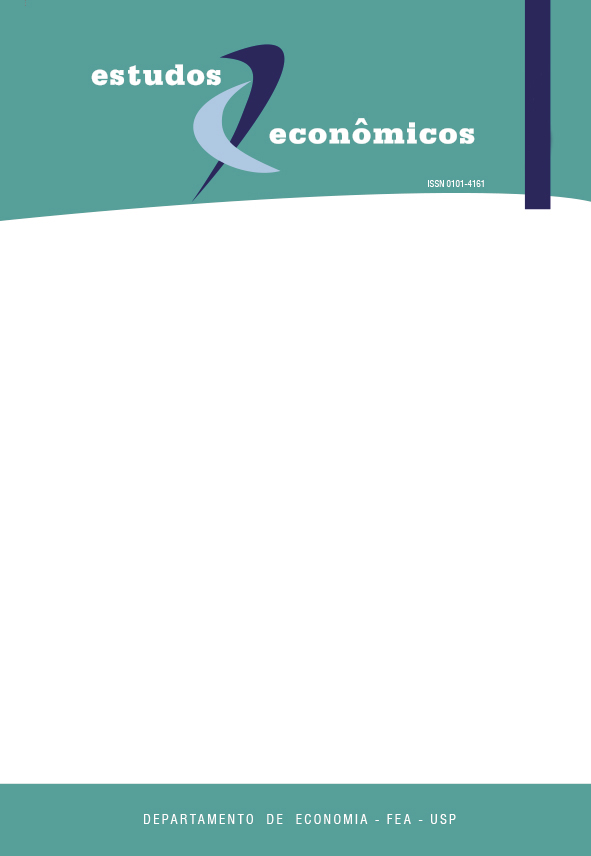Market structure effects on wages in the Brazilian industrial firms
DOI:
https://doi.org/10.1590/S0101-41612011000300001Palavras-chave:
salários, qualificação, estrutura de mercado, indústria brasileira de transformaçãoResumo
Neste artigo analisamos os efeitos da estrutura de mercado sobre os salários na indústria brasileira de transformação entre 1988 e 2008. A ampla base de dados, com informações conectáveis empregado-empregador, tem observações por firma e por trabalhador. Entre elas, estrutura de mercado, salários e qualificação. Controlamos potencial endogeneidade através de experimento quase natural. Há poucos estudos analisando os efeitos da estrutura de mercado sobre salários por firma. Até onde sabemos, este é o primeiro estudo desta natureza para firmas brasileiras da indústria de transformação.
Downloads
Referências
Abowd, J.M., Kramarz, F. (1999a), The analysis of labour markets using matched employer-employee data. In: Ashenfelter, O. e Card, D. (editors) Handbook of Labor Economics, volume 3B, p. 2629-2710.
Abowd, J.M.; Kramarz, F., Margolis, D.N. (1999), High Wage Workers and High Wage Firms, Econometrica, v.67, n. 2, p. 251-333, fev.
Alatas, V., Cameron, L.A. (2008), The impact of minimum wages on employment in a low-income country: a quasi-natural experiment in Indonesia. Industrial and Labor Relations Review, vol.61, n2, p. 201-223, abr.
Andersen, T.M. (2005), Product market integration, wage dispersion and unemployment, Labour Economics, v.12, n.3, p.379–406, jun.
Angrist, J.D., Krueger, A.B. (2001), Instrumental Variables and the Search for Identification: From Supply and Demand to Natural Experiments. The Journal of Economic Perspectives, v. 15, n. 4, p. 69-85, Outono.
Angrist, J.D., Pischke, J. (2009), Mostly Harmless Econometrics: An Empiricist’s Companion. Boston: MIT press.
Autor, D.H., Levy, F., Murnane, R. J. (2006), The Polarization of the U.S. Labor Market. The American Economic Review. Papers and Proceedings, p. 189-194, maio. Special Issue on Measuring and Interpreting Trends in Economic Inequality.
Bertrand, M., Duflo, E., Mullainathan, S. (2004), How Much Should We Trust Differences-in-Differences Estimates? The Quarterly Journal of Economics, v. 119, n.1, p. 249-275, feb.
Besley, T., Case, A. (2000), Unnatural Experiments? Estimating the incidence of endogenous policies. The Economic Journal, v.110, n.467, p. F672-F694, nov.
Brown, C. and Medoff, J. (1989), The Employer Size-Wage Effect. The Journal of Political Economy, v. 97, n.5, p. 1027-1059, out.
Buse, A. (1992), The Bias of Instrumental Variable Estimators. Econometrica, v.60, n.1, p. 173-180, jan.
Bound, J., Jaeger, D.A., Baker, R.M. (1995), Problems with Instrumental Variables Estimation When the Correlation Between the Instruments and the Endogenous Explanatory Variable is Weak. Journal of the American Statistical Association, v. 90, n. 430, p. 443-450, jun.
Cameron, A.C., Trivedi, P.K. (2005), Microeconometrics: methods and applications. Cambridge: Cambridge University Press.
Caves, R.E., Porter, M.E. (1978), Market Structure, oligopoly, and stability of market shares. The Journal of Industrial Economics, v. 26, n. 4, p. 289-331, jun.
Durlauf, S.N., Blume, L. E. (2010), Microeconometrics. The New Palgrave Dictionary. Macmillan.
Guadalupe, M. (2007), Product Market Competition, Returns to Skill, and Wage Inequality. Journal of Labor Economics, v. 25, n. 3, p. 439-474, jul.
Haltiwanger, D. et alli. (1998), International symposium on linked employer-employee data. Monthly Labor Review, p. 48-60. Conference Report.
Lima, M. A. M., Resende, M. (2003), Profit Margins and Business Cycles in the Brazilian Industry: a Panel Data Study. XXXV Encontro Brasileiro de Econometria, Anais, Salvador.
Long, J.E., Link, A. N. (1983), The Impact of Market Structure on Wages, Fringe Benefits, and Turnover. Industrial and Labor Relations Review, v. 36, n. 2 p. 239-250, jan.
Martins, P. S., Esteves, L. A. (2006), Rent-sharing nas indústrias brasileiras. In: de Negri, J. A.; de Negri, F., Coelho, D. Tecnologia, exportação e emprego. Brasília: Ipea. p. 341-365.
Menezes-Filho, N. A., Muendler, M., Ramey, G. (2008), The structure of worker compensation in Brazil with a comparison to France and the United States. Review of Economics and Statistics, v. 90, n.2, p. 324-346, mai.
Meyer, B.D. (1995), Natural and Quasi-Experiments in Economics. Journal of Business and Economic Statistics, v. 13, n. 2, p. 151-161, abr.
Nickel, S. (1999), Product Markets and Labor Markets. Labor Economics, v. 6, n1, p. 1-20, mar.
Pesquisa Industrial Anual. PIA. 1998 to 2005 editions.
Relação Anual de Informações Sociais. RAIS. 1998 to 2005 editions.
Rosenzweig, M.R., Wolpin, K.I. (2000), Natural “Natural Experiments” in Economics. Journal of Economic Literature, v.38, n. 4, p. 827-874, dez.
Schmalensee, R. (1989), Inter-industry studies of structure and performance. In: Schmalensee, R.; Willig, R. D. Handbook of Industrial Organization. Amsterdam: Elsevier. p. 951-1009.
Sutton, J. (1998), Market structure and technology: theory and history. Boston: MIT press.
Waddoup, J. C. (2007), Employer size-wage effects in Australia. Labour, v. 21, n. 4/5, p. 809–835, dez.
Downloads
Publicado
Edição
Seção
Licença
Copyright (c) 2011 Gilson Geraldino Silva-Jr

Este trabalho está licenciado sob uma licença Creative Commons Attribution-NonCommercial 4.0 International License.
A submissão de artigo autoriza sua publicação e implica o compromisso de que o mesmo material não esteja sendo submetido a outro periódico.
A revista não paga direitos autorais aos autores dos artigos publicados.
O detentor dos direitos autorais da revista é o Departamento de Economia da Faculdade de Economia, Administração, Contabilidade e Atuária da Universidade de São Paulo.




